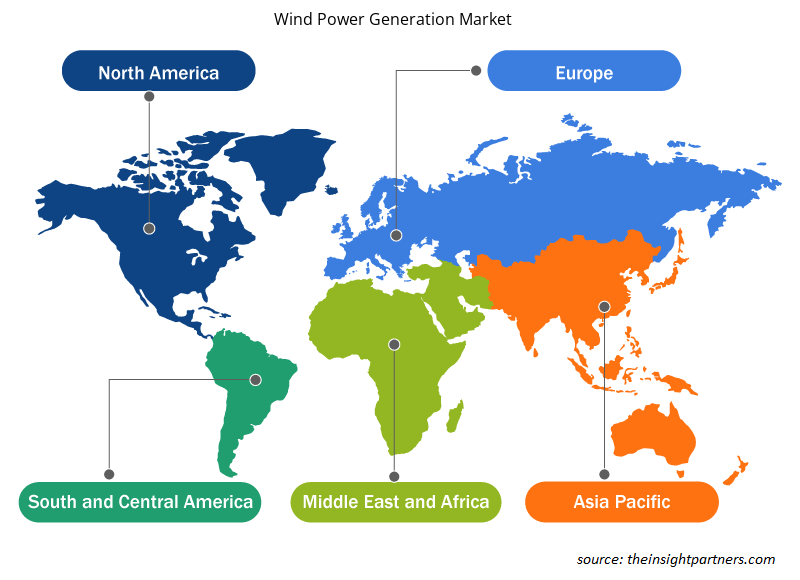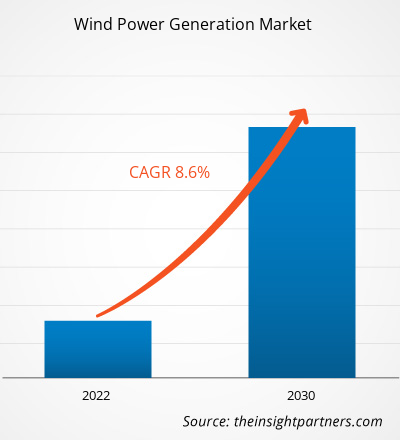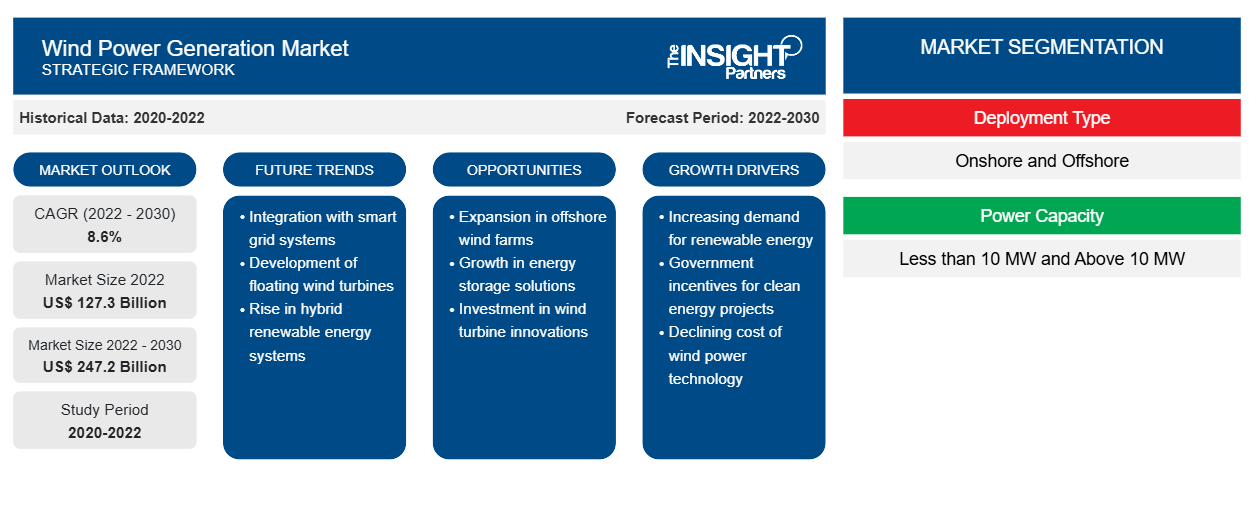[تقرير بحثي] تم تقييم حجم سوق توليد طاقة الرياح بـ 127.3 مليار دولار أمريكي في عام 2022 ومن المتوقع أن يصل إلى 247.2 مليار دولار أمريكي بحلول عام 2030؛ ومن المتوقع أن ينمو بمعدل نمو سنوي مركب قدره 8.6٪ خلال الفترة 2022-2030.
وجهة نظر المحلل:
يشمل نطاق تقرير سوق توليد طاقة الرياح أمريكا الشمالية وأوروبا ومنطقة آسيا والمحيط الهادئ (APAC) والشرق الأوسط وأفريقيا (MEA) وأمريكا الجنوبية (SAM).
من المتوقع أن ينمو سوق توليد طاقة الرياح بمعدل نمو سنوي مركب قدره 11.4٪ خلال الفترة المتوقعة. ويرجع هذا إلى ارتفاع توليد طاقة الرياح البرية والبحرية في مناطق مثل آسيا والمحيط الهادئ وأمريكا الشمالية وأوروبا. ويعزى النمو في سوق توليد طاقة الرياح العالمية في آسيا والمحيط الهادئ في المقام الأول إلى زيادة الاستثمار في صناعة الطاقة المتجددة، والزيادة الهائلة في التصنيع والتحضر، وقدرة توليد طاقة الرياح، ومشاريع الكهربة الجديدة، ومبادرات تعزيز الشبكة. ووفقًا لدراسة جديدة، فإن قطاع طاقة الرياح في منطقة آسيا والمحيط الهادئ مهيأ للتوسع السريع. ومن المتوقع أن يشكل ما يقرب من ربع مزيج القدرة على توليد الطاقة في المنطقة هذا العقد، حيث يحول الطلب المحلي المرتفع على طاقة الرياح البحرية البر الرئيسي للصين إلى أكبر سوق في العالم بحلول عام 2030.
نظرة عامة على السوق:
تُستخدم الرياح لتوليد الكهرباء عن طريق تحويل الطاقة الحركية للهواء المتحرك إلى طاقة توليد. في توربينات الرياح الحديثة، تدير الرياح شفرات الدوار، مما يحول الطاقة الحركية إلى طاقة دورانية. يتم نقل هذه الطاقة الدورانية إلى مولد طاقة الرياح عبر عمود وبالتالي تولد الطاقة الكهربائية. وفقًا للوكالة الدولية للطاقة المتجددة، زادت سعة توليد طاقة الرياح المثبتة عالميًا بأكثر من 95٪ من عام 2000 إلى عام 2022. نمت سعة الرياح البرية العالمية من 178 جيجاوات في عام 2010 إلى 699 جيجاوات في عام 2020، بينما نمت الرياح البحرية بشكل متناسب، وإن كان من مستوى أدنى، من 3.1 جيجاوات في عام 2010 إلى 34.4 جيجاوات في عام 2020.
ومن المتوقع أن تبدأ مشاريع الرياح القادمة في العمل في عامي 2024 و2025، مما سيعمل على تسريع قدرة توليد طاقة الرياح. ووفقًا للتقرير الذي نشرته وكالة الطاقة السويدية في مارس 2022، من المتوقع أن ترتفع الكهرباء المولدة من الرياح من 27.4 تيراوات في الساعة في عام 2021 إلى 46.9 تيراوات في الساعة بحلول عام 2024 في السويد. ووفقًا للتحليل المنشور، من المتوقع أن تزيد السويد من توليد طاقة الرياح بأكثر من 70٪ بحلول عام 2024 مقارنة بعام 2021. تهدف هذه المبادرة إلى تقليل اعتماد البلاد على الوقود الأحفوري والنفط والغاز الذي توفره روسيا. بالإضافة إلى ذلك، أعلنت شركة Ocean Winds، وهي مشروع مشترك بين شركة المرافق الرئيسية في البرتغال، EDP، وشركة Engie الفرنسية، عن خططها لاستثمار 3.15 مليار دولار أمريكي لتطوير مشاريع الرياح البحرية بحلول عام 2025. ويستهدف الشركاء المتساوين في المشروع إنتاج حوالي 7 جيجاوات من القدرة الجديدة. وبالتالي، من المتوقع أن تفيد مثل هذه المبادرات الاستثمارية القادمة سوق توليد طاقة الرياح.
وفقًا لوزارة الطاقة الأمريكية، من المتوقع أن تشهد سوق طاقة الرياح البحرية في الولايات المتحدة نموًا هائلاً في العقد المقبل. إن انخفاض أسعار المزادات البحرية، وزيادة أعماق المياه للمشاريع، وزيادة سعة التوربينات، وانخفاض تكلفة الطاقة المستوية هي اتجاهات سوق توليد طاقة الرياح المستقبلية البارزة والتي من المتوقع أن تفيد نمو السوق من عام 2022 إلى عام 2030. انعكس تأثير COVID-19 في تباطؤ تشغيل المشاريع في أسواق مثل الولايات المتحدة والهند وتايوان. على الرغم من عودة ظهور COVID-19، إلا أن أنشطة مزادات الرياح البرية العالمية ظلت على المسار الصحيح بشكل عام في عام 2021. لعبت الصين دورًا رائدًا من خلال تخصيص ما مجموعه 50.6 جيجاوات من طاقة الرياح البرية في عام 2021، تليها إسبانيا والهند وجنوب إفريقيا وألمانيا. يصور السيناريو العالمي الحالي تدفقًا في سياسات الطاقة ومبادرات السياسة الجديدة وآفاق الاستثمار الضخمة، مما يزيد من مسار منشآت الرياح لتحقيق أهداف الانبعاثات الصفرية الصافية وأمن الطاقة.
قم بتخصيص هذا التقرير ليناسب متطلباتك
ستحصل على تخصيص لأي تقرير - مجانًا - بما في ذلك أجزاء من هذا التقرير، أو تحليل على مستوى الدولة، وحزمة بيانات Excel، بالإضافة إلى الاستفادة من العروض والخصومات الرائعة للشركات الناشئة والجامعات
-
احصل على أهم اتجاهات السوق الرئيسية لهذا التقرير.ستتضمن هذه العينة المجانية تحليلاً للبيانات، بدءًا من اتجاهات السوق وحتى التقديرات والتوقعات.
محرك السوق:
مبادرات حكومية لتشجيع إنشاء مزارع الرياح
ومن المتوقع أن يؤدي الدعم من الحكومات المختلفة من حيث السياسات والاستثمار لزيادة تركيب مشاريع طاقة الرياح إلى تغذية نمو سوق توليد طاقة الرياح على مدى السنوات القادمة. تعمل الحكومة الهندية على الترويج لمشاريع طاقة الرياح في البلاد من خلال استثمارات القطاع الخاص من خلال تقديم حوافز ضريبية ومالية مختلفة مثل فوائد الاستهلاك المتسارع والإعفاء الجمركي التفضيلي على مكونات معينة من مولدات طاقة الرياح . في يناير 2022، بدأ بنك الشعب الصيني (PBOC) في تقديم قروض منخفضة التكلفة لتمويل أنشطة إزالة الكربون. علاوة على ذلك، تركز مبادرات السياسة الحالية في بكين على الإعفاءات الضريبية والقروض منخفضة الفائدة لمطوري المشاريع منخفضة الكربون وإصلاحات سوق الطاقة وتحسين الشبكة. في كندا، من المتوقع أن تدعم مبادرة لوائح الطاقة المتجددة البحرية (ORER) تنفيذ مشاريع الطاقة المتجددة البحرية وخطوط الطاقة البحرية من خلال تطوير لوائح السلامة وحماية البيئة الحديثة لمشاريع الطاقة المتجددة البحرية (ORE) وخطوط الطاقة في المناطق البحرية في كندا.
التحليل القطاعي:
تم تقسيم تحليل سوق توليد طاقة الرياح العالمية حسب نوع النشر إلى برية وبحرية. شكل قطاع النشر البري 80.94٪ من إجمالي حصة سوق توليد طاقة الرياح في عام 2022. ومن المتوقع أن يحافظ على هيمنته خلال فترة التنبؤ. ومن المتوقع أن يسجل قطاع البحرية معدل نمو بنسبة 10.5٪ في السوق العالمية من عام 2022 إلى عام 2030. ويرجع ذلك إلى ارتفاع الاستثمار في منشآت طاقة الرياح البحرية في مناطق مثل أمريكا الشمالية وأوروبا. تعزى توقعات سوق توليد طاقة الرياح في تبني تكنولوجيا الرياح البحرية في المقام الأول إلى زيادة التقدم في التكنولوجيا والمزايا المرتبطة بها والحلول الجاهزة التي تقدمها مختلف مقدمي الخدمات. إن التركيز المتزايد على تحقيق أهداف الطاقة النظيفة يدفع الطلب على طاقة الرياح البحرية العائمة، مما يشكل فرصة محتملة لنمو سوق توليد طاقة الرياح في السنوات القادمة.
التحليل الإقليمي:
وفقًا لتقديرات Insight Partners، في عام 2022، سجلت منطقة آسيا والمحيط الهادئ أعلى حصة سوقية بنسبة 39.8% ومن المتوقع أن تنمو بمعدل نمو سنوي مركب بنسبة 10.6% خلال الإطار الزمني للتحليل، وذلك بسبب الإضافات المخطط لها والمستمرة لمشاريع طاقة الرياح في السنوات القادمة. تشارك دول منطقة آسيا والمحيط الهادئ في تبني استراتيجيات رئيسية نحو أهداف الحد من الكربون وأمن الطاقة لشعوبها من خلال زيادة توليد طاقة الرياح. لتحقيق أهداف الحد من انبعاثات الكربون لعام 2050، تتجه العديد من دول المنطقة نحو توليد الطاقة الخالية من الكربون والاستفادة منها. تعد الهند ثاني أكبر دولة في سوق توليد طاقة الرياح في منطقة آسيا والمحيط الهادئ، بإجمالي تركيب يزيد عن 1.5 جيجاوات في عام 2022. ومن المتوقع أن يؤدي ارتفاع الطلب على توليد الطاقة النظيفة في البلاد إلى دفع نمو سوق توليد طاقة الرياح. تعد أوروبا وأمريكا الشمالية المنطقتين الرئيسيتين اللتين استحوذتا على 28.4% و23.9% من إجمالي حصة سوق توليد طاقة الرياح في عام 2022 على التوالي.
مع النمو السريع للطاقة المتجددة في منطقة آسيا والمحيط الهادئ، ستلعب الطاقة الشمسية وطاقة الرياح دوراً متزايد الأهمية في دمج الطاقة المتجددة المتغيرة وضمان موثوقية نظام الطاقة الإجمالي. وفي العديد من البلدان، لا تزال أسواق تخزين الطاقة ناشئة، ولكن هناك إمكانات هائلة للتطوير. ومن المتوقع أن تستمر قدرة تركيب طاقة الرياح في العالم في النمو لتلبية الطلب المتزايد على الكهرباء وفرص تصدير الكهرباء وتعظيم فوائد مصدر الطاقة المنخفض الكربون والفعال من حيث التكلفة والمرن في جميع أنحاء العالم.
تحليل اللاعب الرئيسي:
تعد شركة Siemens Gamesa Renewable Energy SA، وGeneral Electric، وMitsubishi Heavy Industries، وVestas Wind Systems، وRenewable Energy Systems Americas، وEDP Renewables، وOrsted A/S، وNextEra Energy، Inc.، وEDF SA، وSuzlon Energy Limited من بين اللاعبين الرئيسيين الموضحين في تقرير سوق توليد طاقة الرياح العالمية.
رؤى إقليمية حول سوق توليد طاقة الرياح
لقد قام المحللون في Insight Partners بشرح الاتجاهات والعوامل الإقليمية المؤثرة على سوق توليد طاقة الرياح طوال فترة التوقعات بشكل شامل. يناقش هذا القسم أيضًا قطاعات سوق توليد طاقة الرياح والجغرافيا في جميع أنحاء أمريكا الشمالية وأوروبا ومنطقة آسيا والمحيط الهادئ والشرق الأوسط وأفريقيا وأمريكا الجنوبية والوسطى.

- احصل على البيانات الإقليمية المحددة لسوق توليد طاقة الرياح
نطاق تقرير سوق توليد طاقة الرياح
| سمة التقرير | تفاصيل |
|---|---|
| حجم السوق في عام 2022 | 127.3 مليار دولار أمريكي |
| حجم السوق بحلول عام 2030 | 247.2 مليار دولار أمريكي |
| معدل النمو السنوي المركب العالمي (2022 - 2030) | 8.6% |
| البيانات التاريخية | 2020-2022 |
| فترة التنبؤ | 2022-2030 |
| القطاعات المغطاة |
حسب نوع النشر
|
| المناطق والدول المغطاة |
أمريكا الشمالية
|
| قادة السوق وملفات تعريف الشركات الرئيسية |
|
كثافة اللاعبين في سوق توليد طاقة الرياح: فهم تأثيرها على ديناميكيات الأعمال
يشهد سوق توليد طاقة الرياح نموًا سريعًا، مدفوعًا بالطلب المتزايد من المستخدم النهائي بسبب عوامل مثل تفضيلات المستهلكين المتطورة والتقدم التكنولوجي والوعي المتزايد بفوائد المنتج. ومع ارتفاع الطلب، تعمل الشركات على توسيع عروضها والابتكار لتلبية احتياجات المستهلكين والاستفادة من الاتجاهات الناشئة، مما يؤدي إلى زيادة نمو السوق.
تشير كثافة اللاعبين في السوق إلى توزيع الشركات أو المؤسسات العاملة في سوق أو صناعة معينة. وهي تشير إلى عدد المنافسين (اللاعبين في السوق) الموجودين في مساحة سوق معينة نسبة إلى حجمها أو قيمتها السوقية الإجمالية.
الشركات الرئيسية العاملة في سوق توليد طاقة الرياح هي:
- شركة سيمنز جاميسا للطاقة المتجددة
- جنرال الكتريك
- شركة ميتسوبيشي للصناعات الثقيلة
- أنظمة طاقة الرياح فيستاس
- أنظمة الطاقة المتجددة في الأمريكتين
إخلاء المسؤولية : الشركات المذكورة أعلاه ليست مرتبة بأي ترتيب معين.

- احصل على نظرة عامة على أهم اللاعبين الرئيسيين في سوق توليد طاقة الرياح
التطورات الأخيرة:
تتبنى الشركات العاملة في سوق توليد طاقة الرياح العالمية بشكل كبير الاستراتيجيات غير العضوية والعضوية مثل الشراكة والتعاون والاندماج والاستحواذ. وفيما يلي قائمة ببعض التطورات الأخيرة التي قام بها اللاعبون الرئيسيون في السوق:
سنة |
أخبار |
دولة |
|
2024 |
أقامت وزارة الطاقة الأمريكية شراكة مع الولايات والمعاهد البحثية. وتهدف هذه الشراكة إلى تعزيز تطوير طاقة الرياح البحرية في المنطقة. |
أمريكا الشمالية |
|
2022 |
أبرمت شركة فيستاس شراكة مع شركة بي إي سي إنيرجيا لإنشاء محطة طاقة رياح بقدرة 86 ميجاوات في البرازيل. وبهذا المشروع، تجاوزت فيستاس إنجاز 7 جيجاوات من الطلبات في البرازيل لتركيب توربينات رياح بقدرة 4 ميجاوات منذ عام 2018. |
أمريكا الجنوبية |
|
2022 |
أبرمت شركة سيمنز جاميسا شراكة جديدة مع شركة أزور باور لتثبيت 96 توربينًا مع التركيز على تعزيز صناعة الرياح في الهند. ومن المتوقع أن يؤدي هذا إلى زيادة توليد طاقة الرياح في السنوات القادمة في الهند. |
آسيا والمحيط الهادئ |
- التحليل التاريخي (سنتان)، سنة الأساس، التوقعات (7 سنوات) مع معدل النمو السنوي المركب
- تحليل PEST و SWOT
- حجم السوق والقيمة / الحجم - عالمي، إقليمي، بلد
- الصناعة والمنافسة
- مجموعة بيانات إكسل
التقارير الحديثة
تقارير ذات صلة
شهادات العملاء
سبب الشراء
- اتخاذ قرارات مدروسة
- فهم ديناميكيات السوق
- تحليل المنافسة
- رؤى العملاء
- توقعات السوق
- تخفيف المخاطر
- التخطيط الاستراتيجي
- مبررات الاستثمار
- تحديد الأسواق الناشئة
- تحسين استراتيجيات التسويق
- تعزيز الكفاءة التشغيلية
- مواكبة التوجهات التنظيمية























 احصل على عينة مجانية ل - سوق توليد طاقة الرياح
احصل على عينة مجانية ل - سوق توليد طاقة الرياح